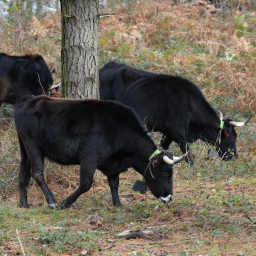NEW
Integrating silvopastoralism into forests to reduce forest fire risk
19 September 2025
- At NEIKER, we coordinate the European LIFE SILFORE project, which seeks to demonstrate the potential of silvopastoralism to reduce the amount of flammable plant material —among other benefits— and thus increase the resilience of forest landscapes.
- Initial results show a reduction of around 40-60% of flammable biomass in the areas under study.
The summer of 2025 was one of the toughest in Spain in terms of forest fires. By mid-August, the fires had scorched more than 343,000 hectares, the highest figure since 1994. The combination of heat waves, prolonged droughts due to our ongoing climate emergency, and a general neglect of rural management has created a scenario in which fires are spreading with unprecedented speed and intensity. This situation has highlighted the need to boost prevention through the active management of agroforestry systems, based on strategies that promote biodiversity and multifunctional land use to help prevent the accumulation of flammable biomass.
In this context, at NEIKER we coordinate the European LIFE SILFORE project to prove the potential of silvopastoralism as an effective tool for preventing fire risk in Atlantic and Sub-Atlantic forests. This practice involves integrating the extensive livestock farming of native breeds —like Terreña cattle and Sasi Ardi sheep in the Basque Country— into forest plantations and woodlands to control scrub growth and, consequently, the amount of flammable material. The project also promotes the transformation of pine forests into mixed forests with more diverse and drought-resistant species, increasing ecosystem stability and functionality.
These actions are complemented by innovative technologies (such as virtual fencing, which facilitates precision grazing without permanent infrastructure) and adaptive management plans that adjust livestock density and forest harvesting schedules based on vegetation development and fire risk.
Through these measures, LIFE SILFORE seeks to reduce the impact of the main factors that drive large fires and rapid fire spread: contiguous vegetation and a lack of structural diversity. Therefore, the creation of forest mosaic landscapes, with different species and layers, introduces discontinuities that reduce the spread of flames and facilitate firefighting efforts.
“Although we are still in the second round of data collection and a third round is yet pending, the initial results indicate a reduction of around 40-60% in flammable biomass in the study areas”, explains Isabel Albizu, a researcher at NEIKER’s Department of Natural Resource Conservation. “With LIFE SILFORE, we are identifying the criteria to be used in each case so that we can apply the most appropriate guidelines in each area. The results depend on factors such as the type of vegetation and its initial state, the choice of animals (they must be hardy native breeds that are well adapted to the environment), the number of grazing days, and the time of year, among other things”, adds Albizu.
Socioeconomic benefits
These structural prevention strategies also translate into socioeconomic benefits. The model allows for reducing forest maintenance costs, diversifying the economy by combining timber production with livestock farming, strengthening forage autonomy, and generating new development opportunities in rural areas thanks to the valorisation of local breeds and job creation.
The project, which will run until 2027, has a broad network of partners on the Iberian Peninsula: the Polytechnic Institute of Bragança in Portugal, the Galician Food Quality Agency, the Galician Forestry Industry Agency, SERIDA in Asturias, and the University of Santiago de Compostela. In the Basque Country, the Orozko Town Hall, the Administrative Boards of Jauregi and Azilu, and the Provincial Councils of Bizkaia and Álava also participate.
Altogether, the consortium has established eleven demonstration areas spread across 92.4 hectares that reflect the ecological and socioeconomic diversity of the northwest of the Iberian Peninsula, with the intention of replicating them in other European regions.
In addition to technical trials, LIFE SILFORE places strong emphasis on knowledge transfer and social awareness. “Guides and digital tools will be developed, and workshops will be organised for managers, forestry technicians, ranchers, and the public, to stress that fire prevention is a collective task that involves recovering traditional practices, promoting extensive livestock farming, and advocating for the sustainable use of forests”, the researcher concludes.




